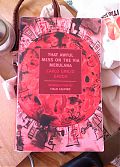
Carlo Emilio Gadda
That Awful Mess on the Via Merulana
Gadda is one of those writers whom when I finish reading I wonder, How has he slipped through my fingers? Why have I not heard his name mentioned before? Why is he not mentioned more? The literate Italians know him, but outside there seems to be a deficit.
While reading online for Clash of Civilizations over an Elevator in Piazza Vittorio I came across a comparison with That Awful Mess on the Via Merulana. Odd, besides long titles, unsolved murder and Rome, these two books have little else in common. Gadda holds a spell over language. While reading That Awful Mess I was aware of the challenge to the translator (William Weaver), as aware of how much I missed in original Italian. Gadda is an inventor, a wielder of dialects, he plays on word combinations, subtly mentions art and politics, he flaunts irony like a pair of chickens. The nearest comparison is Céline, a contemporary. But, Gadda equals only Gadda.
What distinguished Gadda for me on this first reading were the verbal flights into and away and around his main plot; from one page to the next it was impossible to tell what would follow. Unpredictable, sure, but even better: free-form, the mind in flight, swooping in and out and up and down, elusive, where the wind takes you! And then, mama mia! even better, That Awful Mess does not end. The reader delightfully strolls down via Merulana until the sidewalk breaks off, the book simply gives way.
The lack of an ending is funnier still, for That Awful Mess is a murder/theft mystery. Two crimes occur in the same building on via Merulana, one bloodier than the first. The head investigator, Ingravallo, had a crush on the murdered woman, Liliana. Liliana, or her husband, was infertile. As the doctor advised the couple, the only way to find out is to sleep around—Liliana couldn’t. In Fascist Italy, an absence of fecundity was very bad. Liliana was obsessed with her inability to bear children.
“Because that’s how the good Lord is, she said: everything to one person, and nothing to another.” And it is in this guise, indeed that He displays His mysterious perfection.
As the investigation deepens, the reader is brought to various possibilities of a guilty party then away again. Tension builds, then Gadda turns the text to chickens, or a painting, or Mussolini ( omnivisible pig, the Puppet in Palazzo Chigi ), at times with a teeth-gritting irony. A motorcycle drive to the Castelli at dawn turns as many pages as an interrogation. Gadda is doing something similar to Tolstoy’s Napoleon, disseminating a cause to causes.
He [Ingravallo] sustained, among other things, that unforeseen catastrophes are never the consequence or the effect, if you prefer, of a single motive, of a cause singular; but they are rather like a whirlpool, a cyclonic point of depression in the consciousness of the world, towards which a whole multitude of converging causes has contributed.
Who killed Liliana and robbed La Menegazzi? The Fascists, infertility, fertility, love, money, husband, cousin, nieces… What is truth then? An elusive point or multi-faceted layers of people, ideas, thoughts and matter?
Two turns out my door and I’m on sycamore lined via Merulana; now when I walk it, I can go by motorcycle at dawn with Gadda. His Rome of the vernal equinox, plagued by the sirocco, where women are burdened by ferns of finocchio and people burdened by poverty, depicts a Rome unsettled. Murder unsolved, truth as variegated. Carlo Emilio Gadda: nothing is as it seems
· · · · · · · · · · · · · · · · · · · ·